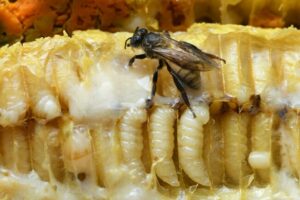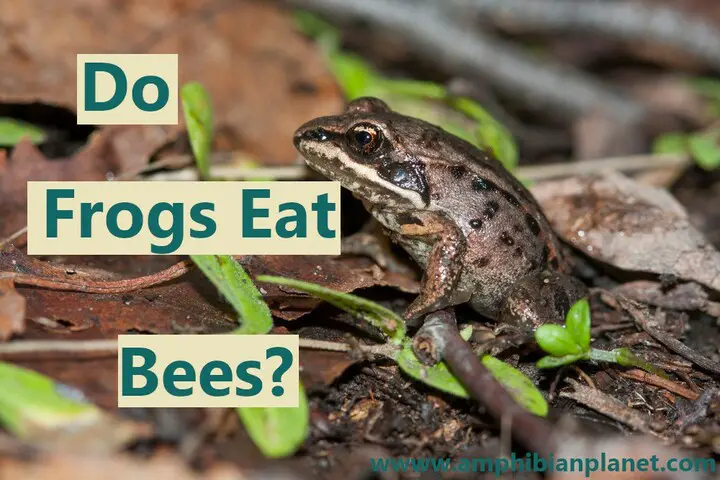Most people know that frogs and toads are generalist carnivores that feast on worms and a wide variety of bugs. However, many people wonder if frogs can eat bees and other stinging insects. So, do frogs eat bees?
In general, frogs do eat bees and bee larvae. They are opportunistic predators that will eat almost any insect they can catch and fit into their mouths, and this includes bees. Toads and other highly terrestrial frogs such as wood frogs will prey on bees much more frequently than aquatic frogs.
That being said, it is important to note that bees will not be the first choice of meal for most frogs. They will eat bees when the opportunity presents itself, but will not purposely seek out bee hives to feast on bees.
Most Frogs Can Eat Bees
Frogs are opportunistic predators with very diverse diets. Smaller frogs mostly eat small worms and a wide variety of bugs, but large frogs such as bullfrogs will also eat smaller amphibians, small lizards, mice, and even small snakes!
If the prey is slow enough to catch and small enough to fit into the mouth, it is on the menu – and bees are not off limits.
If a frog lives in an environment with lots of bees, they too will be on the menu. Sometimes, frogs/toads will even sit by hive entrances to eat bees at night in warm weather. A single frog can eat dozens of bees per night.
Frogs Can Also Eat Bee Larvae & Pupae
In addition to eating adult bees, frogs can eat bee larvae pupae. Since bee larvae (and pupae) are smaller than adult bees, even frogs that are too small to eat adult bees can readily feast on them.

Eating bees in their immature stages is easier and less risky than eating adult bees, as the larvae/pupae cannot fly away to escape, or sting the frog to defend themselves.
Some Frogs Eat Bees More Frequently Than Others
Frogs have diets that depend on the food sources available in their environments. For this reason, terrestrial frogs, especially toads, eat bees more frequently than frogs that spend most of their time in the water.
Aquatic frogs will have a diet that is based on the food available in the aquatic habitats, which will include fish, fish eggs, and aquatic insects.
However, if the opportunity presents itself (e.g. a bee falls into a pond where a frog is), even aquatic frogs will eat bees.
How Do Frogs Eat Bees?
Like other animals, frogs have several highly-developed senses to help them find food. In particular, frogs have eyes that are very sensitive to movement, and their large peripheral vision helps them to spot prey. They can also smell prey with their nostrils.
Once a frog spots a target (which could be a bee), it launches its long, sticky tongue to catch the prey. After catching the prey, the tongue wraps around it and coats it with sticky saliva. The frog will then yank its tongue back with a force equal to twelve times greater than the force of gravity.
Once the prey is in the mouth, the frog will swallow it whole (although frogs have teeth, they do not use them to chew, but rather to maintain a grip on their prey as they swallow it whole).
A frog can shoot out its tongue, capture an insect and pull it back into its mouth within 07 seconds -which is five times faster than the human eye can blink. This speed makes it effective at catching bees, and even fast-flying insects like flies.
Do Frogs Get Stung When They Eat Bees?
When a frog eats a bee, it typically swallows the insect before it can sting. Once the bee is captured, the frog’s sticky saliva covers it and immobilizes it quickly before it’s able to sting; the bee is then quickly swallowed.
Still, sometimes frogs get stung when they try to eat bees. A bee’s stinger can sting and inject venom even after death.
Frogs and toads are not immune to bee venom, so if a frog gets stung, it will feel pain. A single sting is usually not enough to phase most frogs or stop them from eating bees in the future.
However, if a frog is stung several times, it may remember the experience, and learn to avoid bees and other insects that resemble bees for some time. Still, after a while, it may forget about the experience and will catch and eat bees again.
Not All Bees Can Sting
Among bee species that sting such as honey bees, carpenter bees, and bumble bees, males are unable to do so. The stinger is a modified egg-laying device – so only females have them. Male bees typically fly at a target to intimidate and scare them off, but are cannot sting.
Also, there are species of bees known as stingless bees sometimes called ‘stingless honey bees’ or simply ‘meliponines’. These bees are native to tropical regions including Africa, Australia, Asia, and tropical America.

Like honey bees and bumble bees, female stingless bees have stingers – however, the stingers are very small and weak, and are ineffective for defense (i.e. they can’t use their stingers to sting).
Still, stingless bees can use their jaws (mandibles) to bite if their hive is disturbed. In addition, a few stingless bee species have blister-causing secretions in their jaws, which they can use to defend themselves or their hive.
Despite their inability to sting, stingless bees, especially in very large colonies, are still cable of causing serious harm to frogs and most other would-be predators.
Are Bees Good or Bad for Frogs?
Bees are a rich source of protein, fat, fiber, and energy and can be a significant source of vitamins and minerals for frogs.
Bees in their immature stages (while they are still in the larva or pupa stage) will be completely harmless to a frog because they have no stinger. In fact, eating bees in their larva or pupa stage is arguably the most nutritious way to eat bees as they are moister and less crunchy.
The only significant drawback of eating mature bees is they can sting the frog in the mouth or throat. However, once the stinger is taken out of the equation, eating mature bees is not known to be harmful to frogs in any way.
Can Captive Frogs Be Fed Bees?
Although both wild and captive frogs are capable of eating bees, it’s generally not a good idea to offer bees to captive/pet frogs. Bees are very beneficial to the environment as they help pollinate plants.
Studies that bees contribute to 35% of the world’s food production and play a vital role in sustaining the planet’s ecosystems.
Many fruits and vegetables, many nuts, and plants such as sunflowers that are turned into oil depend on bees and other insects to pollinate them to increase their yields and quality. And it’s not only food crops that rely on bee pollination, cotton does as well.
For this reason, is not a good idea to capture bees to feed them to a frog. Not only would you be harming the environment, but your frog could also be stung when it tries to eat the bees. It’s a better idea to only give your frog captive-bred feeder insects and other prey items that cannot harm it.
These prey items can be purchased in a pet store, online, or even from another hobbyist. Most pet shops that sell fish also sell live worms.
Alternatively, you could culture feeder insects at home if you are up for the challenge.
Here is a list of things you can feed a captive frog:
- Worms (earthworms, whiteworms, blackworms, etc)
- Mealworms, Waxworms, Phoenix worms, Silkworms, superworms
- Maggots
- Crickets
- Dubia roaches
- Wingless fruit flies
- Feeder Fish
- Pinkie mice (for large frogs such as bullfrogs)
The most appropriate food will depend on the size and species of the frog. For example, some tree frogs won’t eat mealworms, but will readily eat crickets and wingless fruit flies.
Large frogs, such as bullfrogs enjoy the occasional “pinkie” in their diet. A “pinkie” is a tiny, baby mouse. You can find them in pet stores either alive or frozen although it can be difficult to get frogs to eat the dead/frozen ones.
A varied diet is recommended, so be sure to change up the food items offered to the frog every few feedings.
What Other Predators Eat Bees?
Frogs and toads are not the only animals that prey on bees. Bees and their honey are commonly preyed on by bears, raccoons, and skunks.
In addition, Flycatchers, Bee-eaters, Shrikes, Honey buzzards, and even insects like Praying mantis are known to eat bees. In regions such as Africa, bee hives are also frequently attacked by Honey badgers that feast on honey and bee larvae.
Frequently Asked Questions
Are bees toxic to frogs? Frogs are not immune to bee venom – so when they get stung by a bee, they feel pain. Bees can sting even after death, so an immobilized bee can still sting a frog while it is being swallowed. Besides of risk of stinging, bees are not toxic to frogs when eaten.
What happens if a frog eats a bee? Once a frog spots a bee, it launches its long, sticky tongue to catch the prey. After catching the bee, the tongue wraps around it and coats it with sticky saliva – which immobilizes the bee. Still, a frog can get stung in the mouth or throat if it eats a bee, even if the bee is immobile.
Do frogs eat wasps? Frogs eat wasps when the opportunity presents itself, but they will not be the first food choice for most frogs. If a wasp flies close enough, a frog will eat it. The wasp is immobilized and quickly swallowed before it can sting the frog, although stings do happen on occasion.
Do frogs eat yellow jackets? Frogs do not seek out yellowjackets but will eat them when the opportunity presents itself. If a yellowjacket flies or sits close to a frog, the frog will eat it. The yellowjacket is immobilized and quickly swallowed before it can sting the frog, but sometimes, it may succeed to sting the frog.
Do frogs eat honey? Frogs do not eat honey – however, some captive frogs may benefit from a ‘honey bath’. A honey bath can give energy to weak or lethargic frogs and may help sick/injured frogs to heal.
Conclusion
Frogs have very diverse diets, and bees and their larvae are not off the menu. Toads and other frogs that spend most of their time on land will encounter and eat bees more often than frogs that spend most of their time in the water.
Frogs are not immune to bee venom so they face the risk of getting stung when they try to eat a bee. However, their sticky saliva usually immobilizes the bee before it can sting.
Still, frogs do sometimes get stung when they try to eat bees. A single sting will hurt but will not phase most frogs, but several stings can seriously harm or even kill a frog.


